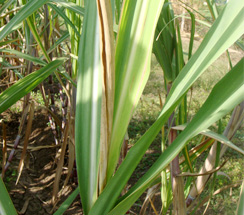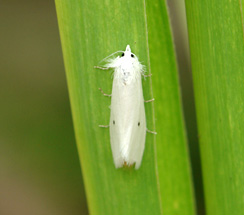Crop Protection :: Pest of Sugarcane
| Top Shoot Borer: Scirpophaga excerptalis |
Symptom:
- Caterpillars are mainly found in the apical portion of canes, boring through the growing point and down the upper joints until it reaches the sappy portion of the stem.
- Dead heart in grown up canes, which cannot be easily pulled.
- Larva bore into unfolded leaves and shows parallel row of shot holes in the emerging leaves.
- Bore holes at the top of the shoot and shows bunchy top appearance.
|
| |
 |
 |
 |
 |
| |
Dead heart |
Parllel shot holes |
Bore hole |
Bunchy top appearence |
|
Identification of pest:
- Egg: Eggs are laid on the lower surface of top leaves in clusters particularly near midribs. The clusters are covered with buff coloured hairs.
- Larva: Smooth, white or cream coloured with a red coloured mid – dorsal line and yellow head.
- Pupa: Pupation takes place within the larval tunnel in a chamber with an exit hole constructed by the caterpillar.
- Adult: White Coloured moth (with a buff orange coloured anal tuft of hairs in female)
|
|
| Management:
Cultural method:
- Use resistant variety CO 419, CO 745 and CO 6516 and tolerant varieties Co 859, Co 1158 and Co 7224.
- Small earthing up followed by trash mulching
- Do not undertake maize, sorghum as intercrops
- Prefer paired row system for planting
- Remove the dead heart plants and destroy them
Physical method:
- Collect and destroy the egg masses.
- Collection of egg masses on campaign basis once in 4 days initiating the collection from the day of moth emergence
Biological method:
- Release Ichneumonid parasitized Gambroides (Isotima) javensis @ 100 pairs / ha as prepupal parasitoid.
- Selective destruction of unparasitized eggs by placing the egg masses in 30 mesh nylon bags that permit escape of adult parasitoids while containg the neonate larvae hatching from unparasitized eggs.
Chemical method:
- Application of Carbofuran 3G 1 kg a.i/ha or Thimet 10G 3 kg a.i/ha ten days before the commencement of 3rd brood in sub tropical india.
- Application is done by opening a small furrow near the root zone, placing the granule followed by a light irrigation
|
Content Validators:
Dr.V.Jayakumar, Senior Scientist (Plant Pathology), Sugarcane Breeding Institute, Coimbatore -641007.
Dr.T.Ramasubramanian, Senior Scientist (Entomology), Division of Crop Protection, Sugarcane Breeding Institute, Coimbatore -641007.
Dr.M.Ravi, Assistant Professor (Entomology), Krishi Vigyan Kendra, Sirugamani- 639115.
Source of Images:
http://agropedia.iitk.ac.in/sites/default/files/8%20pupae.jpg |
|








